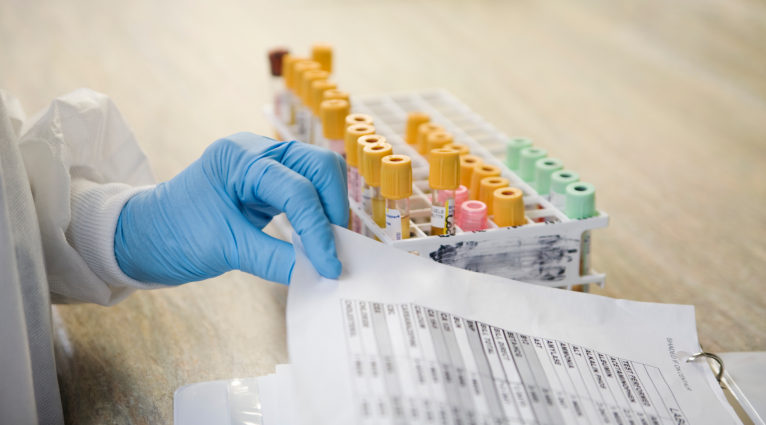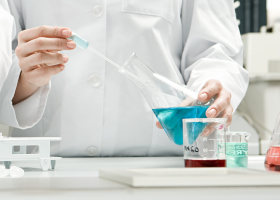Good Laboratory Practice (GLP)
Good Laboratory Practice or GLP is a quality system of management controls used by research laboratories and organizations to direct how nonclinical health and environmental safety and efficacy studies are planned, performed, monitored, recorded, archived, and reported. GLP does not apply to studies that utilize human subjects, human specimens, clinical studies, or field trials in animals.

The scope of GLP is confined to studies performed on animals, plants, microorganisms, or subparts of these. It is intended for use in nonclinical laboratory studies within industry, academia, government, or other testing facilities.
Good Laboratory Practice should be applied to test items contained in pharmaceutical products, pesticide products, cosmetic products, veterinary drugs as well as food additives, feed additives, and industrial chemicals. These test items are frequently synthetic chemicals, but may be of natural or biological origin and, in some circumstances, may be living organisms.
World Health Organization
Other test items that require GLP include:
- Color additives
- Food packaging
- Medical devices
- Other non-pharmaceutical products or ingredients
- Some bio-products
GLP aims to ensure that nonclinical safety testing has:
- Consistency
- Integrity
- Quality
- Reliability
- Reproducibility
- Uniformity
GLP guidelines and regulations are set forth by the US Food and Drug Administration (FDA), Environmental Protection Agency (EPA), and US Department of Agriculture (USDA), as well as the Organization for Economic Cooperation and Development (OECD) international guidelines. The OECD Principles of Good Laboratory Practice have been widely accepted and codified as law by countries worldwide.
A Brief History of Good Laboratory Practice
| 1972 | New Zealand introduced Good Laboratory Practice as the Testing Laboratory Registration Act. Denmark also passed a law to promote Good Laboratory Practice. |
| 1975 | The FDA received a tip that there were problems with tests submitted by one of its biggest testing partners—Industrial Bio-Test Laboratories (IBT). |
| 1976 | An FDA inspection found extensive evidence of fraud and abuse in IBT laboratories. As a result of the investigation, more than 70% of studies audited by the FDA were invalidated. In response, Congress proposed and enacted the Good Laboratory Practice Regulations (GLP) for FDA as part of the Federal Food, Drug, and Cosmetic Act (FD&C). |
| 1978 | The Good Laboratory Practice Regulations, Final Rule was published in the Federal Register. Organization for Economic Cooperation and Development (OECD) Principles of Good Laboratory Practice were first developed. |
| 1979 | Title 21 Code of Federal Regulations Part 58—Good Laboratory Practice for Nonclinical Studies became law. |
| 1981 | OECD Principles of Good Laboratory Practice were formally recommended for use by member countries. |
| 1983 | EPA proposed Good Laboratory Practice guidelines for pesticide toxicology studies in two parts—Toxic Substances Control Act (TSCA) and Federal Insecticide, Fungicide and Rodenticide Act (FIFRA). |
| 1987 | 21CRF Part 58 was amended with GLP changes related to quality assurance, protocol preparation, testing, control article characterization, and retention of specimens and samples. |
| 1989 | EPA 40 Code of Federal Regulations Part 160—Federal Insecticide, Fungicide andRodenticide Act (FIFRA) was enacted. It includes regulations requiring GLP compliance for studies that support or are intended to support applications for research or marketing permits for pesticide products regulated by the EPA. EPA 40 Code of Federal Regulations Part 792— Toxic Substances Control Act (TSCA) was enacted. It includes regulations requiring compliance with GLP for studies relating to health effects, environmental effects, and chemical fate testing of chemicals regulated under the Toxic Substance Control Act. |
| 1997 | Revised OECD Principles of Good Laboratory Practice were adopted. |
| 2000 | FDA issued Toxicological Principles for the Safety Assessment of Food Ingredients with guidelines for designing and conducting toxicity studies, including GLP. |
GLP Principles
The Principles of GLP were first published by the Organization for Economic Cooperation and Development (OECD) in 1981 to detail organizational processes and conditions under which laboratory studies are planned, performed, monitored, recorded, and reported. The OECD GLP Principles set forth requirements related to human resources, spatial considerations, and specific units. Areas of responsibility are also covered in the OECD’s GLP Principles.
The OECD’s Good Laboratory Practice Principles are as follows.
1. Test Facility Organization and Personnel
- Test Facility Management—ensures test facilities comply with GLP principles.
- Study Director—acts as a single point of study control and is responsible for the overall conduct of the study as well as the final study report.
- Principal Investigator—ensures that delegated parts of the study follow GLP principles.
- Study Personnel—must:
- Be knowledgeable of GLP principles that apply to their part of the study.
- Comply with instructions set out in the study plan and Standard Operating Procedures (SOP) for the study.
- Promptly and accurately report raw data.
2. Quality Assurance Program
Test facilities should have a documented quality assurance program with dedicated personnel to ensure that the study is in compliance with GLP principles. Included in the quality assurance program are:
- Copies of study plans and SOP
- Inspections, including study based, facility-based, and process-based, with records of results
- A final report that includes details about each inspection (e.g., dates, study phase)
3. Facilities
Test facilities should be of suitable size, construction, and location to meet the requirements of the study and minimize disturbance that could interfere with the study’s validity. Facilities should include:
- Test system facilities
- Facilities for handling test and reference items
- Archive facilities
- Waste disposal
4. Apparatus, Material, and Reagents
Equipment should be suitably located of appropriate design and capacity to support study. All apparatus should be periodically inspected, cleaned, maintained, and calibrated according to SOP. Chemicals, reagents, and solutions should be labeled with identity, concentration, and expiration date.
5. Test Systems
Physical / chemical and biological test systems should be suitably located and maintained to ensure the quality of the data and adherence to GLP principles.
6. Test and Reference Items
- Receipt, Handling, Sampling, and Storage
- Maintain records, including test item, reference item characterization, date of receipt, expiration date, and quantities received for use in the study.
- Identify handling, sampling, and storage procedures to ensure homogeneity and stability.
- Include identification information, expiration date, and storage instructions on storage containers.
- Characterization
- Identify each test and reference item (e.g., code, Chemical Abstracts Service Registry Number [CAS number], name, biological parameters).
- Define each batch of the test or reference items (e.g., batch number, purity, composition, concentration).
- Record stability of test and reference items under storage and test conditions.
- Retain samples of each test item.
7. Standard Operating Procedure (SOP)
Test facilities should have an SOP to ensure the quality and integrity of the data generated by the facility. An SOP should be created for each of these areas:
- Test and Reference Items—receipt, identification, labeling, handling, sampling, and storage
- Apparatus—use, maintenance, cleaning, and calibration
- Computer Systems—validation, operation, maintenance, security, change control, and back-up
- Materials, Reagents, and Solutions—preparation and labeling
- Record Keeping, Reporting, Storage, and Retrieval—coding of studies, data collection, preparation of reports, indexing systems, handling of data, including the use of computerized systems
- Quality Assurance Procedures—operation of quality assurance personnel in planning, scheduling, performing, documenting, and reporting inspections.
8. Performance of the Study
A study plan should be created prior to the start of the study. It should be approved by the study director and verified for GLP compliance. The study plan should include the following.
- Identification of the study, test item, and reference item
- Information about the sponsor and test facility
- Dates (i.e., approval date, dates for start and completion)
- Test methods
- List of records to be retained
- Conduct of the study
9. Reporting of Study Results
A final report should be prepared for each study. It should include:
- Identification of the study, test item, and reference item
- Information about the sponsor and test facility
- Dates (i.e., approval date, dates for start and completion)
- Statement of types of inspections that were done
- Description of test materials and test methods
- Results
- Summary of results
- Information and data required by the study plan
- Presentation of results, including calculations and determinations of statistical significance
- Evaluation and discussion of results, including conclusions
- Storage—study plan, samples, raw data, and final report
10. Storage and Retention of Records and Materials
Items that should be stored include:
- The study plan, raw data, samples of test and reference items, specimens, and the final report of each study
- Records of all inspections performed
- Records of qualifications, training, experience, and job descriptions of personnel
- Records and reports of the maintenance and calibration of apparatus
- Validation documentation for computerized systems
- Standard Operating Procedures
- Environmental monitoring records
The principles of Good Laboratory Practice (GLP) promote the quality and validity of data generated in the testing of chemicals and prevent fraudulent practices.
European Commission
GLP and the OECD
The Organization for Economic Cooperation and Development (OECD) published GLP Principles in 1981 and recommended that their members use them. The OECD Principles of Good Laboratory Practice ensure the generation of high-quality and reliable test data related to the safety of chemical substances and preparations. In addition, the principles help harmonize testing procedures for the Mutual Acceptance of Data (MAD).
The OECD’s MAD system provides a standard set of requirements, facilitates cooperation among countries, and reduces barriers to trade. OECD countries and full adherents have agreed that a safety test carried out following the OECD Test Guidelines and Principles of Good Laboratory Practice in one OECD country must be accepted by other OECD countries for assessment purposes.
The United States (US) is a full adherent GLP member country of OECD. Therefore, studies conducted in the US in compliance with the FDA and EPA GLPs are accepted by full adherent and provisional adherent OECD member countries.
According to the OECD, MAD criteria for a nonclinical health and safety test study are:
- 1. The study must have been conducted according to OECD Test Guidelines and OECD Principles of GLP;
- 2. The study must have been conducted in a test facility which has been inspected by a national GLP compliance monitoring program and;
- 3. The national GLP compliance monitoring program must have undergone a successful evaluation by OECD.
If all three criteria are met, all OECD member countries as well as adherents to MAD must accept the study data.
GLP and the FDA
The FDA conducts careful inspections of facilities that perform nonclinical laboratory studies to assess compliance with 21 CFR 58 (Good Laboratory Practice for Nonclinical Laboratory Studies). Compliance is intended to assure the quality and integrity of the safety data filed according to relevant sections of the Federal Food, Drug, and Cosmetic Act and the Public Health Service Act.
The FDA guidelines for GLP compliance include the following.
- Evidence that products are safe in research and / or marketing applications must be submitted by sponsors of nonclinical laboratory studies to support the safety of:
- Animal drugs
- Animal food additives
- Electronic products
- Food and color additives
- Human drugs and biological products
- Medical devices for human use
- Nonclinical laboratory studies that must comply with FDA GLP regulations include:
- Observed no adverse effect levels
- Potential teratogenic, carcinogenic, or other adverse effects
- Risks of clinical studies involving humans or animals
- Safe levels of use
- Toxicity profiles
- Compliance with GLP regulations is not required for these studies:
- Basic research
- Discovery
- Screening
- Other studies in which the safety of the product is not being assessed
GLP and the EU
Directive 2004/9/EC of the European Parliament and of the Council on the inspection and verification of good laboratory practice (GLP) was passed in February 2004. The European Union (EU) directive codifies rules governing the inspection and verification of the organizational procedures for laboratory studies.
It also sets forth rules related to the conditions under which laboratory studies are planned, performed, recorded, and reported for the nonclinical testing of all chemicals. EU Member States must verify the compliance with the GLP, as defined by the Directive, for any testing laboratory within their territory claiming to use GLP.
Member States shall designate the authorities responsible for the inspection of laboratories within their territories and for the audit of studies carried out by laboratories to assess compliance with GLP.
Directive 2004/9/EC Article 3
Good Rules for Good Results
In any pharmaceutical or chemical development company, one of the essential aspects of product development is GLP. Using incorrect practices in the lab can lower the quality of the product and may jeopardize the entire project.
GLP principles and fundamental requirements provide the foundation for laboratories to run safely, efficiently, and faster. Beyond meeting compliance requirements, following GLP principles results in overall better performance on all levels.
Egnyte has experts ready to answer your questions. For more than a decade, Egnyte has helped more than 16,000 customers with millions of customers worldwide.
Last Updated: 7th November, 2021



